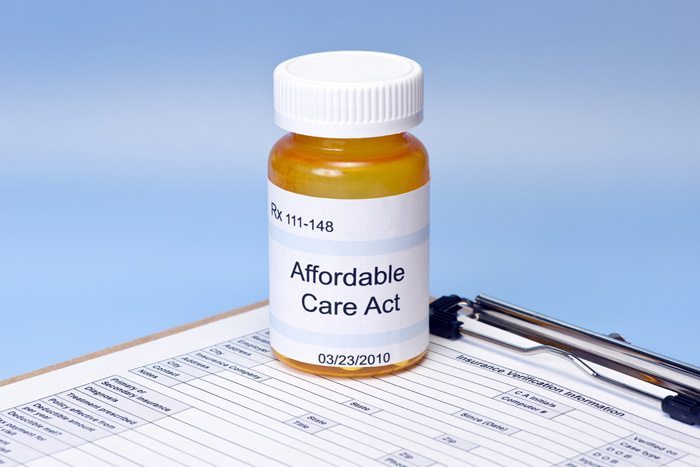A Look at the Affordable Care Act Enrollment Numbers
In states that didn't expand Medicaid, like Pennsylvania, the number of people left in the coverage gap exceeds the number of newly insured.

The Affordable Care Act enrollment numbers have come in. Then they were out. Now they seem in again.
As has been widely reported, more than eight million people enrolled in health insurance plans through the marketplace during the enrollment period, according to the Department of Health and Human Services. That’s good news. It’s also good news that more than a quarter of the enrollees were in the all-important 18 to 34 age group.
While President Obama was still cooling down from his victory lap, conservatives began challenging the 8-million figure. Then the United States House Committee on Energy and Commerce released what seemed like a bombshell report indicating that only 67 percent of enrollees in federally facilitated marketplaces (FFMs) paid their premium through April 15. That would mean, of course, that President Obama was offering the public fluffy numbers.
The committee editorialized on the statistic, lamenting the numbers revealed the Obama administration’s “sad reversal away from its vows of transparency.” But then it turned out that the committee’s report wasn’t correct. For one, it excluded Idaho and New Mexico, which are currently running federal exchanges while working out details for state-run exchanges, according to the Kaiser Family Foundation. The 67 percent figure failed to account for the notable late surge in enrollment and that, due to extension, the first premium for millions of enrollees was not due until after their declared data cut-off date of April 15.
Subsequently, insurers submitted written testimony clarifying that they anticipate between 80 and 90 percent of enrollees will pay their first premium.
The see-saw will likely sway back to conservatives again, to an unknown degree, if “winning” means fewer people having health insurance. There will likely be some kind of drop in enrollment due in part to what longtime health policy observer Trudy Lieberman calls “the great cost shift.” As Lieberman explains it, shifting the burden of health-care cost to consumers has been going on for years, but the Affordable Care Act will help the slow grind snap into focus as new enrollees pleased with affordable premiums discover high copays and out-of-pocket costs.
Most significantly, as all these subsets of numbers shake out, there’s the Medicaid issue, also known as “the final battle in the war over Obamacare.”
After the Supreme Court decided that states could opt out of Medicaid expansion, 24 states did just that. The result is that more than 4.8 million people enrolled in Medicaid and the Children’s Health Insurance Program since the exchanges opened in October, and nearly all of that growth occurred in states expanding Medicaid. An estimated five million people are stuck in the gap, not earning enough to earn subsidies for the exchange and earning too much to qualify for traditional Medicaid.
In states that didn’t expand Medicaid, like Pennsylvania, the number of people left in the coverage gap exceeds the number of newly insured.
According to the Department of Health and Human Services, 318,077 Pennsylvanians signed up for insurance through the marketplace exchange as part of the Affordable Care Act. Pennsylvania’s enrollment represents 24.9 percent of the potential marketplace population.
Though 318,077 is a significant dent in the uninsured population, the number of people who signed up is still less than the number of people forced to go without coverage as a result of Gov. Corbett’s decision not to expand Medicaid.
The “affordable” part of the Affordable Care Act was designed to operate on a continuum.
Residents who earn between 100 and 400 percent of the federal poverty level (FPL) are financially assisted by earning tax subsidies when they purchase a private plan through the exchange.
Medicaid expansion was intended to cover people who earn less than 138 percent of the FPL but do not qualify for traditional Medicaid. Currently in Pennsylvania, parents must earn less than 33 percent of the FPL (approximately $8,953 for a family of four) in order to qualify for Medicaid. Able-bodied adults without children can’t qualify at all.
While politicians quibble over the eight million figure, the real problem with the enrollment numbers come from the gap. The Affordable Care Act was intended in part to whittle economic-induced health disparities by increasing access to health insurance; the partisan refusal to expand Medicaid instead has created significant access disparities rooted in geography.
Advocates estimate that some 500,000 Pennsylvanians are left in the coverage gap. Currently, a family earning $45,000 a year is eligible for financial assistance toward health insurance, while a family earning $9,000 a year is not.
A full quarter of Pennsylvanians earn between zero and 138 percent of the FPL.
Instead of expansion, Corbett has been pushing for an alternative plan his administration calls Healthy PA. The plan cuts benefits to current enrollees and features controversial mandates such as monthly premiums and job search requirements, and has been harshly criticized by healthy policy experts and advocates for the working poor.
House Democratic Leader Frank Dermody articulated Harrisburg Democrats’ frustration with Corbett’s plan, calling it a “complex scheme” and a “political ploy” that requires extensive negotiation and “will cover fewer people and will end up costing more than simple Medicaid expansion.”
Meanwhile, Gov. Corbett is up to re-election this fall. All Democratic primary candidates have vowed to accept Medicaid expansion, if elected.
